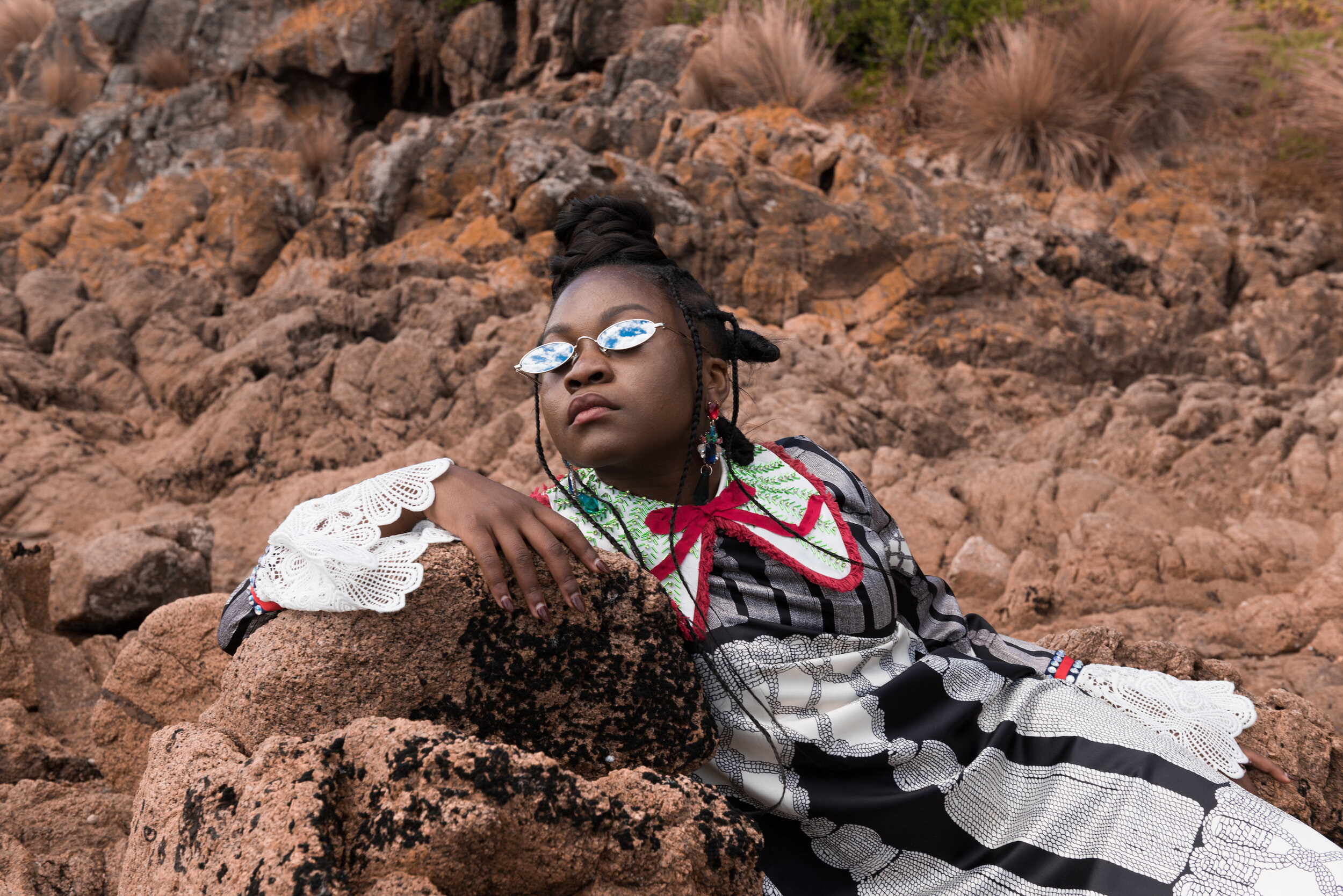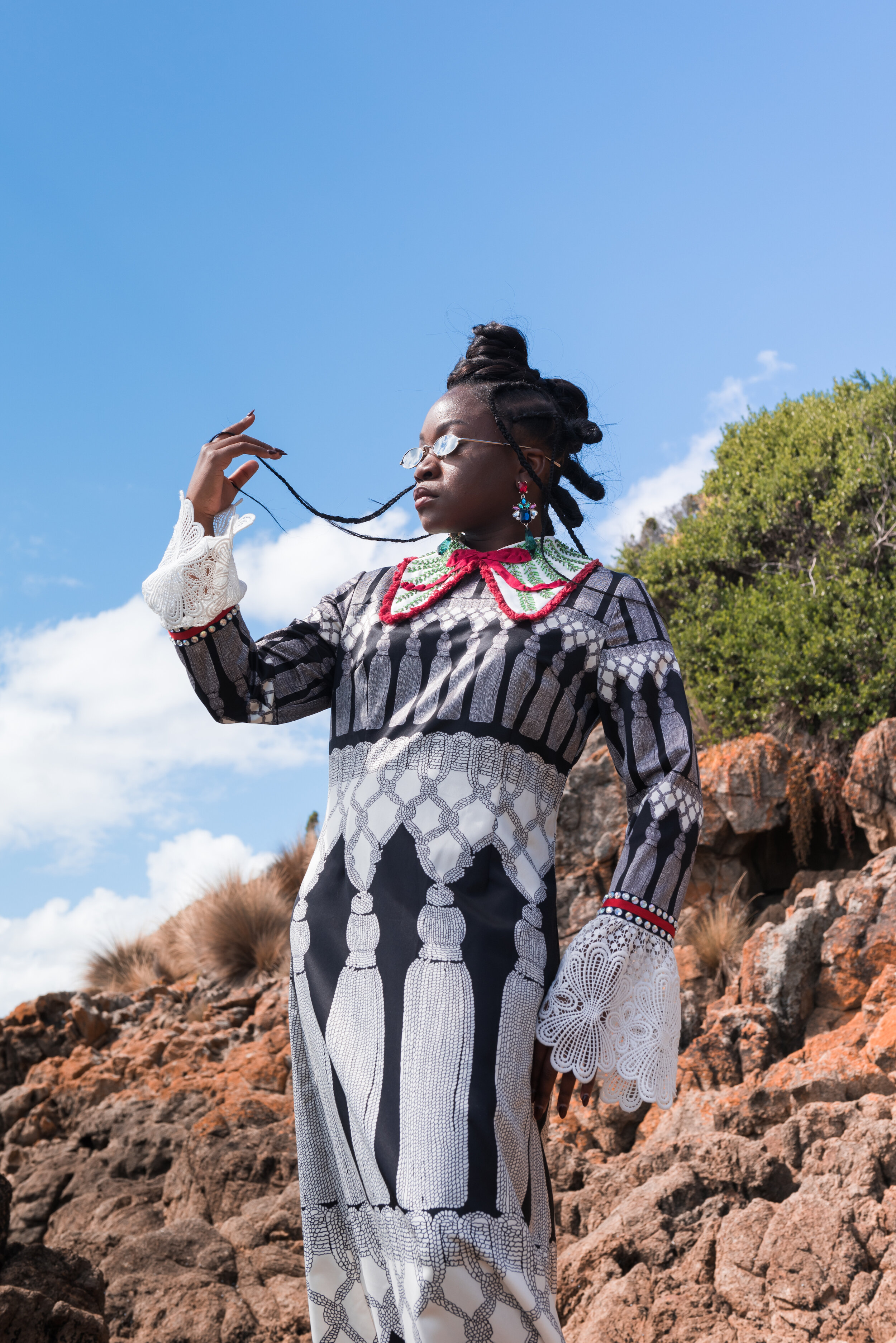Brown girl on the hill
Smack-bang in the middle of her journey to greatness, Sampa the Great takes time to shoot the breeze.
Words Maxine Beneba Clarke | Photos Prue Stent & Honey Long | June 2018
Photo: Prue Stent & Honey Long. Styling: Ntombi Moyo | Dress: Shag; earrings: Lovisa; crown: Sampa’s personal piece from Nigeria.
When Sampa the Great sings, her harmonies sit easy. Lackadaisical on the beat, and sounding more than a little Morcheeba. Everybody hero. Everybody hero. Everybody hero. When Sampa the Great raps into the bass, her style is harder to liken: a low-growl listen-up afro-lilt. Street, but village. Maybe Missy Elliot meets Angélique Kidjo. But there’s something here about Sampa’s voice too. Local, I mean: a lean to her rhymes that sure-reminds me of the early days of Sista She. Born in Zambia, raised in Botswana, made in Australia (in terms of her catapult into the music industry, at least). It’s not so much that Sampa is world, as so many artists of colour get boxed. It’s that the world is inside-a her: gloves on, fists raised and fighting mighty to be spat out.
Sampa Tembo’s true-tricky to chase down. Manager says she’s taking a break: chilling with friends and family over the Christmas period. I’m big-wise to artist fatigue, so I leave the story-hunt for a bit. It’s flip-bang in the middle of a hot Australian summer the day we finally meet. We’re both running behind, both running on black time. The navigator on my phone’s messing with me. I’m sweating down St Kilda Road, walking the burning kerb between Melbourne tram line and public garden, when suddenly I spot her: Sampa the Great, sitting casual atop a grassy hill, surveying her Kweendom.
Tembo’s smaller than her rhymes declare: near a half-foot shorter than average-high me. Hip-casual in a light grey stretch-dress. Red-purple nails. Dark grey sneakers (aqua-emerald trimming). Silver necklace hanging low. Jet black afro pushed back with headwrap. I’m trying to remain hey-there cool, same-time as frantically cataloguing her style. Presence-wise, Tembo’s bigger than she broadcasts though, which is quite a trip, given the soul-stir of her music. On stage, she is swagger but not bravado. Charisma, but not ego. Roar, but not shout. In person she is softly spoken and without persona: sitting honest-easy in her own skin. Just her. Stylish, yeah, but undeniably her. Which is its own kind of greatness.
“Tembo’s legs are stretched out on the grass in front of her. Her clenched fists jive up around her face. Her upper-body’s dancing, like it can taste a new beat. ”
Tembo tells me that the greatness in her title was a deliberate bigging-up: a petite African diaspora female MC on the Australian hip-hop scene. Perhaps this confidence was always there. Or perhaps she has now grown to fit the title. Either way, it hovers over her, glinting like a crown. To know what a mammoth accomplishment this ease-of-being is, is to know what it’s like to be a black woman in the world. And I do.
Tembo initially came to Australia for university. Graduated, but the beat kept calling: a longing that lodged itself inside of her and would not be moved. I ask Sampa Tembo about the migrant child thing. We, of the diaspora, know the pressure well. The want-the-best-for-you familial opposition. Borne of love. “They want a good life for us, you know,” I work my way to the topic. “And sometimes it’s hard when we say to our parents: I’m going to be an artist.” Tembo emphatically nods her head. “You know it.” We together-laugh for more than a moment. So how have hers dealt? Did they resist? Have they swung round? Tembo smiles and nods a little. To both things. She talks me to way back in the day, when her olds watched her performing poetry, or singing in church. Offers a recent victory: back home one evening, she caught her Mama watching footage of one of her shows. She glimpsed a flash of wonder, dancing across the face of the woman who birthed her. “Mum looked up and she said, I can’t believe that’s little Sampa. Up there, performing for all those people!” We’re both silent, for a moment. The trees rustle behind us. A bird calls overhead.
Tembo’s first recorded offering, The Great Mixtape, hit headphones in 2015. She’s travelled a long way in a short time since then. Don’t we always say that about artists—black women especially. Like they raised themselves way up out of absolutely nowhere. As if there wasn’t a steep climb, and they never worked like fuck to against-all-odds wrestle down some true-big thing.
Tembo just kept on keeping on: doing her hardworking thing. People started to remember her music, and her name. I said: we don’t need another hero. I said: we heroes ourselves. The EP HERoes dropped two years after Mixtape. Then came her latest offering, Birds and The Bee9.
She’s supported Kendrick Lamar and Thundercat. Collaborated with Estelle. Shared the mic with some heavy-duties of the rap and hip-hop world. But I’m not here for Sampa-played-guess-where-supporting-you’ll-never-guess-who. I want to know how Sampa the Great makes music. How she rounds out that hip-hop-meets-reggae-meets-funk-meets-soul sound. How she poets. I want a seat in the maestro’s studio. “I started off clapping, stamping my feet. And before you know, there were hums. Sways.” Tembo’s legs are stretched out on the grass in front of her. Her arms are bent at the elbow. Her clenched fists jive up around her face. Her upper-body’s dancing, like it can taste a new beat. Then, all a-sudden, like a remembering-of-where-she-is, Tembo stops short of singing and runs back to my question. “You know, I don’t have a formula. I never want to limit growth.”
“People would send me their beats. I listened to them, and wrote to them. You would send me a beat, and I would reflect it. People would email me. Or you know, something would just come from someone on social media. Social has totally upped the game.” How do you choose from all the rhythms that subwoof your inbox? Was the starting point for your early tracks always a beat that you just right away fell in step with? “A lot of the time. But you know, sometimes there would be hesitations. Sometimes I would think: that’s definitely not my style, but can I challenge myself ?” These days, Tembo’s moving away from writing to ready-made beats, and writing “from the ground up”, though she remains open to both ways of working.
I grill Tembo about the language of collaboration: the way creative minds meet and make in the studio space. “Sometimes I’ll say I’d really like this to be warm,” she laughs, talking about the importance of finding a producer and a team who get you. “I’ll say I’d really like this to be warm and orange. And somehow, they’ll know what I’m saying. But you have to find the right person, or people. You have to connect.” The scorching afternoon sun is burning over her shoulder: golden glow silhouetting afro-curl.
“The world around us slow-moves. This somehow doesn’t feel like an interview-proper. Just two brown girls on a grassy hill, shooting the artistic breeze.”
Comes the moment to broach the race and hip-hop audiences in Australia thing. “You know, it’s always there,” she says. “The music world is a microcosm of the real world, so anything that’s a society problem seeps in. You can’t get away from it... and I went from rapping to Africans to rapping to Australians. It’s the same material, but sometimes you introduce things differently. You get up on stage and say”—she adopts a firm, calm, teacher-like voice—“So... don’t be alarmed. But I kind of need to talk to you about something...” We both guffaw. It’s funny ’cause it’s true. “And sometimes it’s about, How can we get more black people into these venues? Why are they not here? Is it the venue? Is it the amount the tickets costs? It’s about making sure we understand these spaces.”
I’m interested too, in how audience impacts a show, in the difference between playing to a black-brown body-jam of dancers at a free street festival in Footscray, and a sea of white stranger-faces at a packed venue in Europe. “There’s always a planned set,” Tembo explains. “But you know, I tweak the freak out of it. Sometimes the other musicians I perform with are like—” She looks quizzically over shoulder, making a scrunched up WHAT-IN-THE-HELL-ARE-YOU-DOING-BACK- THERE? face. “But nothing’s ever set in stone. I’m a performer. I read the crowd.”
At the time we meet, Tembo’s at the neat tail end of a European tour. “I was new to them. In Australia, they know my music. But then there’s that universal thing hip-hop does, so they got excited about the sound. The Parisians were really interesting though—because they didn’t even know me, but they were on it, you know, instantly vibing to the sound.”
The world around us slow-moves. My pen scratches quickly across the paper. This somehow doesn’t feel like an interview-proper. Just two brown girls on a grassy hill, shooting the artistic breeze. Several hundred metres in front of us, traffic passes by. Other Melburnians relax back around us, on the botanical garden lawns. A whisper-puff of long white cloud low-floats behind the tall office buildings lining St Kilda Road.
“If you could collaborate with anyone—any artist in the world—who would it be, and why?” I’m leaning eager-forward for her answer, like we’re playing childhood Truth or Dare. Tembo answers almost before I finish the question. “Lauryn Hill, for sure. She’s incredible. She was one of the first artists who really got me listening. What she did with her music! I mean, when you win the game: congratulations,” Tembo pauses. “But when you win the game, and the game was not even meant for you: props!” She raises both hands her hands above her head, in worship to her sis-hop Goddess.
Photo: Prue Stent & Honey Long. Styling: Ntombi Moyo | Top: Shag; overalls: Shag; shoes: Zara; earrings: Lovisa.
I ask if there’s anything she really wants to chat about. “Something no-one’s ever asked you about, that you always think damn, I wish somebody had gone there.” There’s always something. Tembo thinks for a moment, quiet. “The video-making process,” she decides. “Collaborating with visual artists to make something that gets people involved in the music.” Her favourite visual project is about to drop. “I think it’ll be out in March. Maybe April.” She’s painstakingly tight-lipped, but veritably bursting to tell more.
In the weeks following our chat, I creepy-stalk Sampa the Great’s Instagram feed. I see a tease of what she maybe, probably, almost- definitely means. In the seconds-long teaser, the words black girl magik appear in white cursive across the screen. A full cast of lace-dressed Beyoncésque black Kweens are seated at a long table, a serious-looking Sampa the Great at the head. Let them see your magik—quadruple spacebar—coming to you soon.
On March 9, my socials light up with photos of a stunned-looking Sampa the Great: proud-holding an intricate golden trophy bigger than her head, having just scooped the Australian Music Prize for Birds and the Bee9. It’s her Lauryn Hill analysis that my mind immediately conjures. When you win the game, congratulations. But when you win the game, and the game was not meant for you: props! Please, somebody phone Ms Hill.
This piece first appeared in Swampland issue four.




